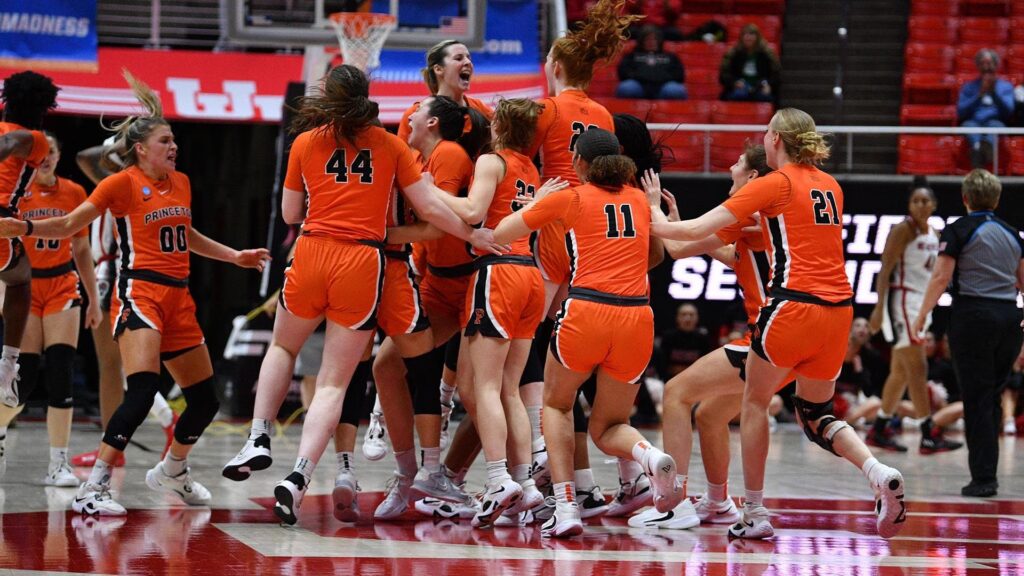On January 9, 2025 there were five or more upsets of the top 25 ranked women’s college basketball (WCBB) teams. What did they have in common? The Muse delved deeper and reviews the upsets from the top 25 teams between November 2024 through January 22, 2025. This post explores the making of an upset.
While following too many games at once, the Muse missed the making of an upset as Vanderbilt (Vandy) beat No. 15th ranked Tennessee (TN) 71-70. The Muse was watching other live games on television and following the Vandy-TN game on the phone using the play-by-play tab on the ESPN application (app). In the fourth quarter nearing the end of the game, it read: 0:04 TN made layup TN 70 and Vandy 69. Vanderbilt time out followed. The app posted 0:00 Vanderbilt missed layup TN 70 and Vandy 69. The 0:00 stayed for awhile. The Muse swiped up and stopped glancing at the phone. It was here on the play-by-play that the Muse sighed for Shea Ralph and the Commodores-so close, and returned to live games on television.
Later on the Muse noticed that the final score was Vandy 71 and TN 70. Huh? What happened? There were four more 0:00 entries. The Muse left the play-by-play tab and the game too soon. The app posted 0:00 Vandy offensive rebound; 0:00 Vandy made jumper TN 70 and Vandy 71; 0:00 End of 4th quarter; 0:00 End of game. Mikayla Blakes of Vanderbilt got an offensive rebound off of the missed lay up and tipped in the winning basket at the buzzer! An instant classic. Vanderbilt upsets Tennessee.
There is an adage in baseball that good pitching can stop good hitting. Is it true in WCBB? Can stifling defense stop great offensive teams? Was this the making of an upset? The Muse began with the team statistics in the Vandy and TN game. The difference for Vanderbilt was better three-point shooting percentages, more free-throws taken and made, plus fewer fouls. What about the prior upsets of the top 25 teams from earlier in the season? What were the prevailing trends?
Generally, the most common trend in the making of an upset is that the winning teams have better three-point shooting percentages (%). Great defense is a contributor.
The second most common trend and related to the first trend is that the winners have an overall better field goal shooting percentages (% FGs). Results of a committed and mindful defensive approach.
Tied for third, but a drop off from the first two trends are that the winners had more rebounds, plus shot and made more free throws (FTs). Rebounding is related to energy and desire attributes.
In fourth place was that the winners committed fewer fouls. Hard to accomplish with an emphasis on an aggressive defensive posture, but doable.
The least common and most surprising trend was that the winners had fewer turnovers (TOs). The Muse thought that this would be higher on the trend list, but not so. Taking care of the ball with solid passing and dribbling was quasi-important. It was a 50-50 break out. Sometimes the winners had more TOs than the losers. What do these trends suggest?
On the offensive end, the best chances for being in a game, staying in a game, or creating an upset is with players, who can shoot the ball, specifically three-point shooters. So, recruit shooters. Institute an offensive scheme that drives the ball to the basket in a north-south direction and pass out to open shooters. Get fouled on the drive, then take and make more FTs than the opponent.
On the defensive end, teach a stifling player-to-player defense. Avoid less aggressive standing around zones that guard space and not people. Recruit long, quick athletes, who are willing to play this style. Pick up full court. Hockey line substitutions. Give it your all for 3 to 4-minutes. Play a denial defense, on the passing line and up the passing line. Active feet, arms, and hands are needed. Move. Of course doing this without fouling is a refined art form and practiced technique. Find players that like to rebound the ball, those who instinctively hang around the basket, find an opponent, put a body on them, box out, and go get the stray ball. No matter the player’s size.
If I’m a high school coach – the Muse would pick up full court on every possession and press-press-press. Smother all shooters, especially 3-pt shooters. No breathing room to launch a shot. To this Muse fewer turnovers should matter, but trends indicate otherwise. Sound passing and ball handling are important fundamentals. Watching sloppy games is hard. Teams with too many TOs don’t seem deserving of the win.
At the highest level in the Women’s National Basketball Association (WNBA), top players standout by their +/- for the game. This means tracking how the score changes during their minutes played. Great players also have many double-doubles or triple-doubles in statistical categories. Some come to mind including Napheesa Collier MN; A’ja Wilson LV; Breanna Stewart NY; Caitlin Clark IN; Dearica Hamby LA; Kahleah Copper PHX; and Arike Ogunbowale DAL. In the NBA they are LeBron James LAL; Karl-Anthony Towns NY; Jayson Tatum BOS; Domantas Sabonis SAC; Shai Gilgeous-Alexander OKC, Giannis Antetokounmpo MIL; Anthony Edwards MN; and Nikola Jokic DEN.
Ideal hoops consist of two-way offensive and defensive players. Those that aggressively defend, rebound, can shoot the rock consistently from distance, can drive the ball to the basket, and make their teammates better. A couple of these types of players on a team can keep games competitive – even against opposing all stars or All Americans. They potentially create the making of an upset.

Photo from NCAA.com. No copyright infringement is intended.
